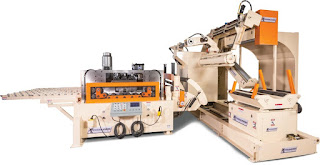But sometimes when we speak about our equipment, we’re met with blank stares. Much in the same way parents are when they speak about their children.
In our case though, it’s not because our pressroom equipment could use some discipline or is just not that interesting. Because it IS interesting.
The stares typically come from those who are never on the factory floor. And it’s because they simply don’t understand the terminology.
So we’re gonna break it down for you. Let’s start with the basic three:
1. Coil Reel (a.k.a. Uncoiler, Side Winder, De-Coiler, De-Reeler, Pay Out Reel)
When your buddy Tom refers to the coil reel - or any of its various aliases - he’s talking about a revolving spool-shaped device on which metal is wound.
It has an expanding mandrel that grips the inside diameter of the coil and rotates as the material is pulled off of the coil.
2. Straightener (Flattener, Powered, Pull-thru)
If your sister Louise tries to explain that a straightener will really fry your hair, she’s probably talking about a different straightener. Unless she works in a factory - in which case she should keep her distance from the straightener.
In any event, straightening involves the action of taking metal stock of various shapes and passing it through a series of staggered rolls - the rolls usually being in horizontal and vertical planes - or by reeling in two-roll straightening machines.
3. Roll Feed (Servo)
Generally speaking, roll feeds have two rolls mounted on top
of each other which are set to pinch the material between them. When those rolls rotate, the material is advanced through the die in the amount at which the feed is set.
Roll feeds are activated by servomotors (servo roll feeds).
Conventional Feed Lines
Now, take the coil reel, the straightener and the roll feed we discussed above and arrange them just so and you have a conventional feed line.
The coil reel operates by using brake tension - either with a friction brake or one that’s motor-generated. When the material reaches the straightener, the machine operates with variable speed control so that the pulling operation can combine high loads and dynamics with smooth acceleration and deceleration.
In some cases, there is a coil loop between the straightener and roll feed for increased comfort and safety. It can be bridged for threading, either manually or hydraulically.
The final link in the feed chain - the roll feed - is the component that gives the whole operation its pulse.
Compact Line (SmartSaver, SpaceSaver)
These are the desired feed lines when there are issues with floor space utilization. And challenges with floor space are especially real for those of us in the stamping industry. That’s because conventional lines require a lot of space for slack loops in light-gauge and medium-gauge processing.
But when a compact line is specified, a feed line length of 40 to 50 feet can be reduced by as much as half. How does this miracle occur? Not through angels. Compact lines simply combine the three functions of unwinding, straightening, and feeding into one machine.
So how does this work with the heavier-gauge applications? A cradle/feeder/straightener design is the go-to for saving floor space. And just what is a coil cradle? Not something to rock factory babies to sleep in, that’s for sure.
Coil Cradle
The purpose of a coil cradle is to help unwind coils in rough production environments. (Not altogether different from how a cradle helps babies unwind when the going gets rough - i.e. “enough with the mashed peas already.”) They typically work with thick and narrow materials and are mostly combined with a straightening unit.
Coil cradles offer some advantages:
- simple handling of even high-tensile materials with a strong clock-spring
- short set-up times
- elaborate coil handling concept which allows for rewinding of unfinished coils
They’re just plain good for space-challenged operations.
And this brings us to two other terms you’re likely to hear and maybe not understand.
1. Air Feed
Contrary to how it sounds, this isn’t the practice of acquiring all one’s nutrients from the air. (This practice is called breatharianism and it’s a real thing. A real scary thing.)
Anyhow, an air feed is used to feed raw material into the die in a stamping press. The method generally requires two air-powered gripping devices, as well as an adjustable-stroke air cylinder which is set to push the material through the prescribed amount.
2. Leveler
As its clever name implies, a leveler is used to level (or flatten) a rolled sheet, strip, or plate by reducing or eliminating distortions. This is usually achieved by drawing the material through a series of rolls on the leveler, which are set to alternately flex the material up and down.
So there you have it.
All the jokes aside, we take our machinery very seriously and are proud of our work. We hope this post helped you to better understand what happens on our factory floor from day to day.
And if you have any “pressing” pressroom equipment concerns, feel free to contact us. We’re always happy to help. Really. We are.





No comments:
Post a Comment